Verdict
The Bluetti AC200L combines a decent amount of energy storage with a fairly high peak output, making it suitable as a portable backup to almost any device in the home. It’s well-served for ports, and remains quiet and unruffled even when providing its maximum power output. Throw in fast charging, good solar support, and a reasonable app, and the AC200L is a very impressive device overall – particularly if you can pick it up for its discounted price of around £1400.
Pros
- Quite a heavy-duty supply
- Quiet and efficient, even at high loads
- Good value
Cons
- Top mains power sockets are compromised
- Very difficult to move around
-
A medium-heavy duty power stationThe AC200L can store 2,048 watt-hours of electricity, and satisfy peak demands of 2.4 kilowatts (kW). That’s enough to run most household goods including laundry devices, but it’s a bit short for some kettles or heaters. -
A good range of ports, but heavyThis power supply has four USB ports, four mains outputs and a car power port. It can charge from the mains, solar power, or both, potentially filling up in less than 90 minutes. It weighs almost 30kg, though.
Introduction
If you want a highly portable battery power supply, the Bluetti AC200L isn’t it. At 28.3kg and about the size of a microwave, it’s probably more accurate to describe it as ‘movable’.
Don’t let that count against it, though: it’s the unavoidable downside of packing in enough Lithium Iron Phosphate (LFP) batteries to store 2048 watt-hours of electricity – that’s roughly enough to run a kettle for 40 minutes.
This is a fairly heavy-duty supply, then, and Bluetti has made the most of its size by fitting in four USB ports, a car-style power socket, and four mains sockets. These can output a maximum of 2.4 kilowatts (kW) between them, which is enough to run almost anything except the most demanding heaters and kettles – and the AC200L has a trick up its sleeve to cope with those, too.
The AC200L competes with other mid-heavy duty supplies including Anker’s SOLIX F2000, which has fairly similar specifications. So, how does it shape up?
Design and features
- Not very portable
- Plenty of ports
- Useful app control via Wi-Fi or Bluetooth
It’s important to be clear that the Bluetti AC200L really isn’t something you’d want to move about very often. It’s certainly too heavy for a single person to lift for any distance, and even a fit and healthy person would find it an effort to get it up a flight of stairs.
This makes it much less suitable for large camping groups than the SOLIX F2000, which has wheels and a telescopic handle to help you shift it around.
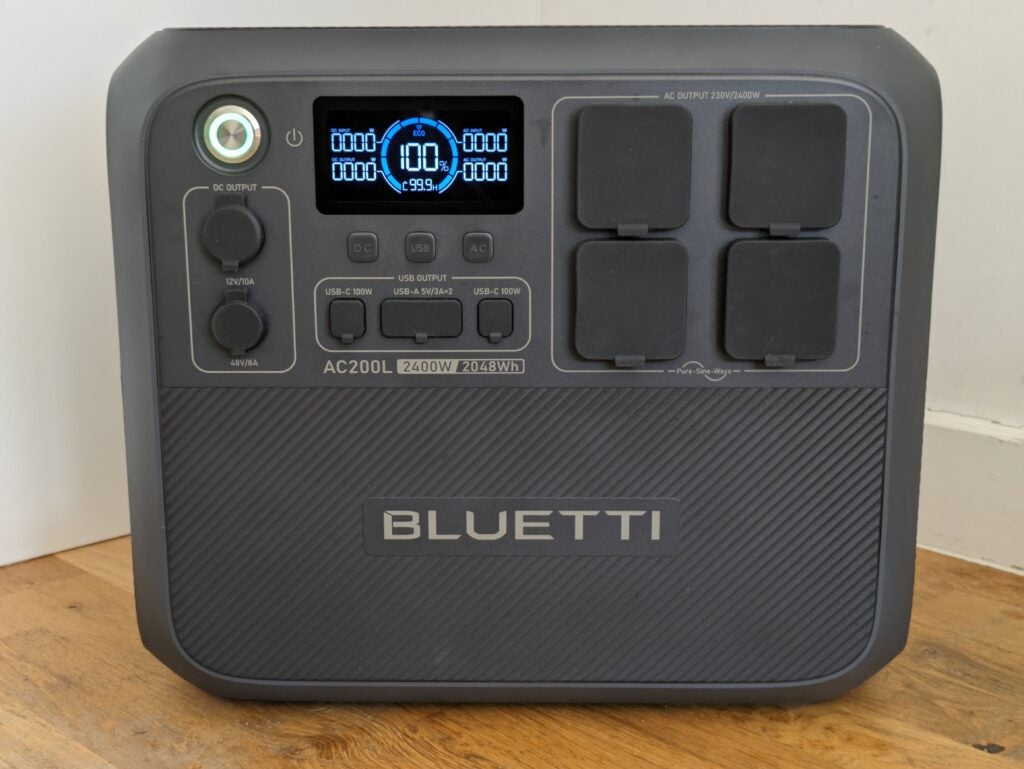
Viewed as a movable supply for the home or a small camper van, however, the AC200L makes lots of sense. It can store enough energy to power a fridge-freezer for a day or two, or cover at least one wash load in a modern machine. It’s certainly up to making a few rounds of toast or several pots of coffee, although you might need to alternate between high-power kitchen or laundry devices to avoid overloading it.
All of the AC200L’s power outputs are on the front panel, and each is covered by a thick rubber bung. These give some protection against a small splash of dust or water, but the AC200L isn’t weatherproofed. Its four USB ports are split between two USB-A sockets, each rated for up to 18W, and two USB-C ports each good for 100W. The cigarette lighter-style car outlet is rated for 120W, while there’s an additional 48 volt, 8 amp RV outlet.
This power supply’s four AC sockets are arranged in a square, but the top two are inverted. This could be helpful if you’re connecting a device placed behind it, but it also means that top-heavy AC adaptors can obstruct a neighbouring socket.
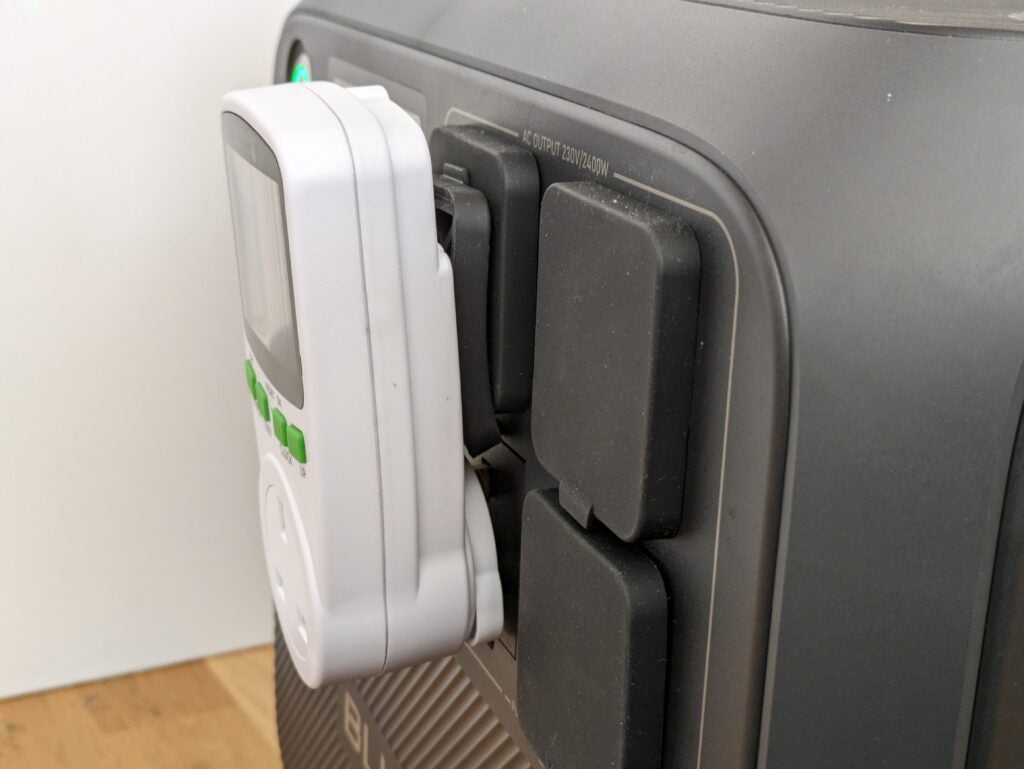
More significantly, I found that the bungs on the top sockets wouldn’t completely fold clear of the cable exit from a standard plug, meaning that I couldn’t get them fully inserted. The bottom sockets don’t have this problem. If I was keeping my sample, I’d consider removing the bungs from its top sockets.
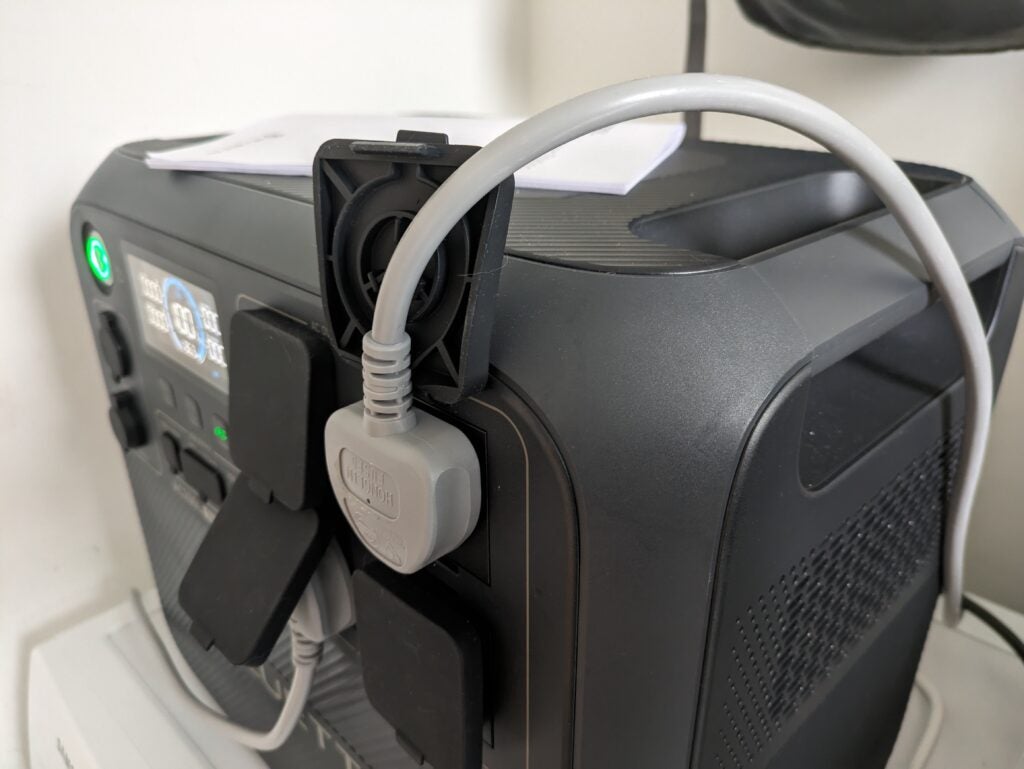
Bluetti has also put screw caps or bungs over the various power input ports, which are clustered together on the AC200L’s left-hand panel. You connect it to the mains via an unusual circular port, to which the supplied cable is secured by a locking ring. DC power sources connect to a similar two-pole port, while there’s also a grounding connector – handy to have if, for some reason, your grid connection doesn’t offer earthing.
Bluetti supplies DC cable adaptors for car and solar charging, though it’s worth noting that the latter uses MC4 connectors, rather than the XT60 plugs you get on most portable solar panels.
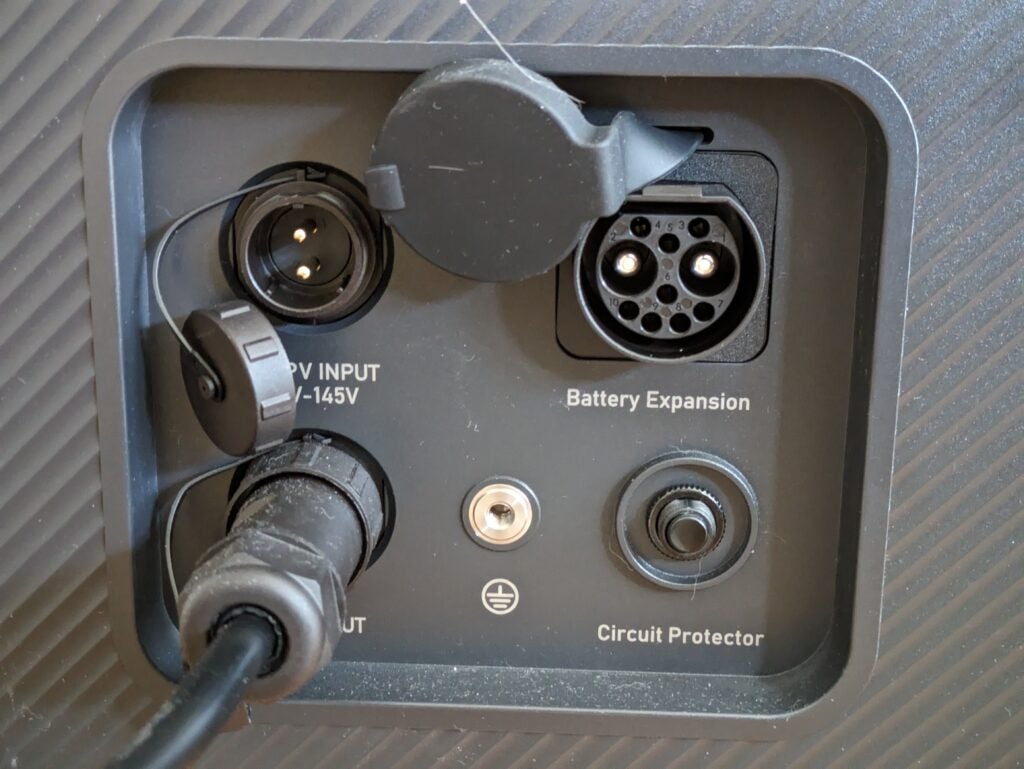
The final port is a heavy-duty expansion connector supporting a range of external batteries. You can double the AC200L’s storage to 4096Wh with a single Bluetti B230 battery, or take it to 6348Wh with two B210 units. You can even add two B300 batteries to get a 8192Wh maximum. Note, though, that adding batteries just increases the AC200L’s stamina – it doesn’t expand the maximum 2400W of power it can deliver at any given moment.
This power supply uses a typical Bluetti display, which shows at a glance the battery state and whether it’s charging, discharging or neither. Either way, there’s also an estimated time until the battery is full or empty, together with the detail of incoming and outgoing AC and DC power. My only real complaint is that when these values are zero, the screen displays zeros rather than simply showing nothing – it’s quite busy as a result.
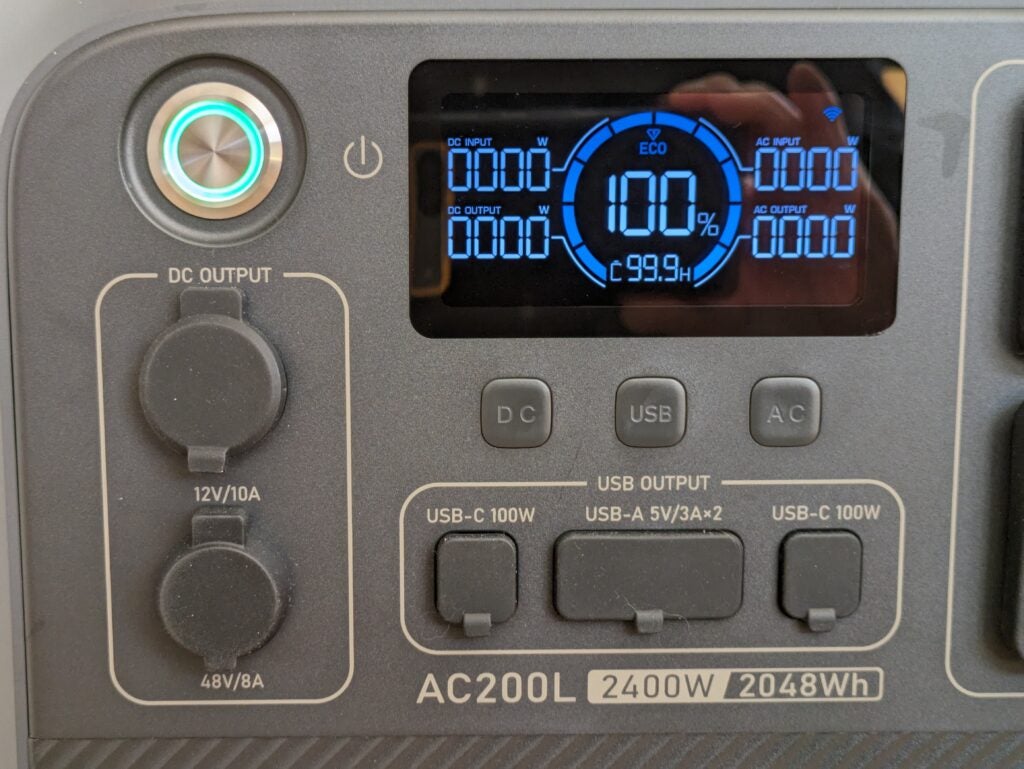
Things are clearer in the app. Here you can also switch the AC, DC and USB circuits on and off, and it’s easier to configure the various charging modes.
The app also makes it simple to configure the AC200L’s Eco feature – which can switch off the various outputs when they’re no longer being used – and to enable the Power Lifting mode.
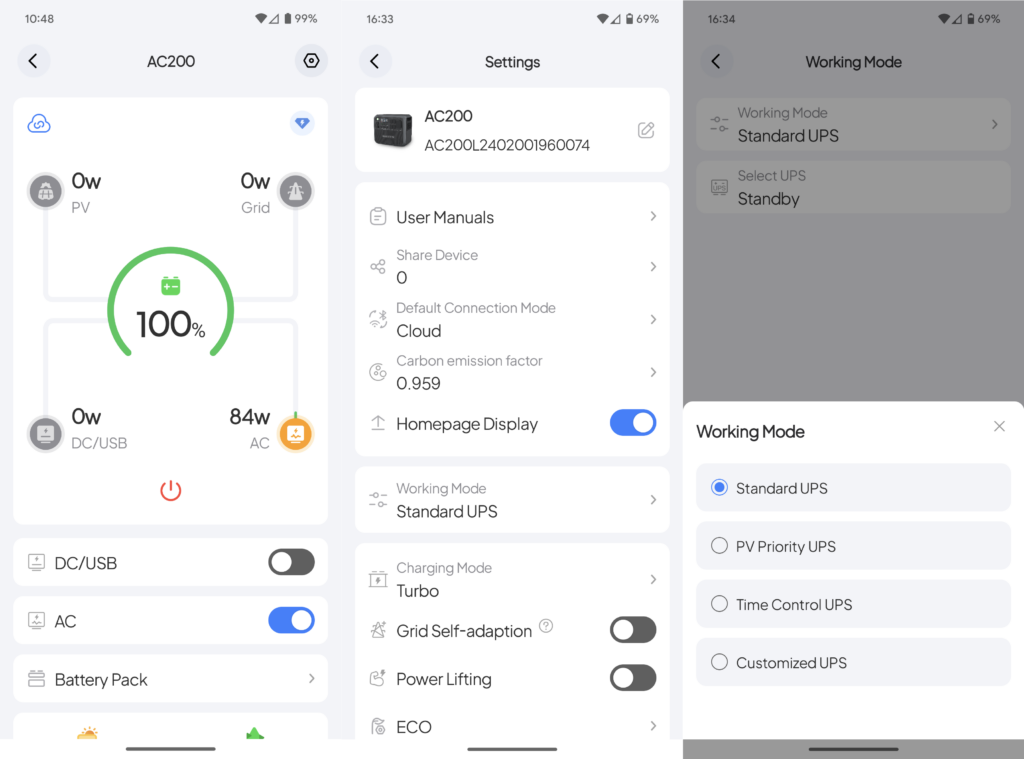
The Bluetti AC200L can operate as an uninterruptible power supply in four different modes. The default setting keeps the battery charged with whatever power is available until it fails, at which point the AC200L switches to the power stored in the batteries.
In time-control mode, the AC200L can be scheduled to charge using off-peak electricity, then provide battery power during peak times to help lower your bills. There’s a PV-priority mode, in which priority is given to charging from available solar power, but you can configure your own custom behaviour if you prefer.
Charging
- Charge from mains, car, or the sun
- Maximum 2400W total charging power
- Full recharge in less than 90 minutes
As you’d probably expect, the Bluetti AC200L can be charged from mains power, the sun, or a car. Given that the latter tops out at 120W, you’d need to be on a transcontinental jaunt to fully recharge its 2048Wh batteries – it would take more than 17 hours. Better to stick to mains charging, which is supported at up to 2400W, or use solar panels with a maximum of 1200W. You can combine both for a maximum of 2400W, comprising 1200W from each.
The AC200L defaults to 1200W mains charging. In this mode, I timed a full recharge at two hours and six minutes, with a total power consumption of 2.35 kilowatt hours (kWh). Assuming this took the 2.05kWh batteries from fully empty to fully charged, that’s an efficiency of 87.3%. It was fractionally more efficient in the ‘Silent’ charging mode, which took just under three hours, consuming 2.34kWh for an efficiency of 87.6%.
I wanted to test the fastest ‘Turbo’ charging mode, but this was initially a bit disappointing, with the AC200L dropping from 2400W charging down to 1200W after adding only 15% or so to the battery. I needed to try again after the AC200L had cooled, after which it remained at 2400W until it was nearly fully charged. A full recharge took 75 minutes – 15 minutes quicker than Bluetti’s claims. In this time, the AC200L used 2.4kWh, for a charging efficiency of 85.3%.
It’s worth pointing out that the Silent charging mode is a misnomer, as the fan will operate occasionally when it’s needed. Still, even when charging flat out, the AC200L remained quite quiet, and was easy to background among the noise of my home office.
One niche concern is that you can’t limit the AC200L’s charging below about 800W. That might make it unsuitable for situations where you only have a very limited mains connection available, such as a low-power campsite hookup or a low-power generator.
Performance
- Stable power output with very quiet fans
- Good round-trip efficiency
- Mighty Power Lifting mode
As with most other battery power supplies I’ve tested, the Bluetti AC200L had no problem providing its rated 2400W for as long as the battery lasted. To probe its performance at full power, I used it to charge two other battery power stations demanding 2200W and 200W, for a 2400W total. The AC200L displayed a sustained output of around 2.49kW, and fully discharged its battery over 49 minutes, providing 1.77kWh in the process.
After recharging, I tested the AC200L two more times with a 1050W mid-range load, and a 200W low power load. It provided 1.9kWh and 1.76kWh respectively in these tests, giving an overall efficiency of between 86.0% and 92.6%. That’s impressive. I calculated a more round-trip (charging and discharging) efficiency of 81.1% – only a point or so down on the best I’ve seen.
I usually connect power stations to a USB load and measure their capacity when providing DC power, but here I encountered a problem. My standard load is another power bank, capable of either providing or accepting power over USB-C. For some reason, the two devices couldn’t agree which was providing the power, and the smaller bank wouldn’t charge. While I’ve not had this issue before, it’s a bit of a niche problem, unlikely to be an issue for the average user.
I also wanted to test this power supply’s Power Lifting mode, which is broadly equivalent to the SurgePad feature appearing on the latest alternatives from Anker. Both are designed to run certain devices that have a power rating above the power station’s normal capacity. They do this by limiting the output voltage and current to prevent the connected device from drawing its full rated power. This works perfectly with simple ‘resistive’ devices like a kettle, but it’s not suitable for voltage-sensitive appliances such as dishwashers, microwaves or the like.
The AC200L’s strong output power makes it harder than usual to test this. Only certain electric heaters and kettles are suitable, and I didn’t have any rated between the supported 2400 and 3000 Watts. Instead, I combined my 1800W-rated kettle and 1250W toaster for a theoretical 3050W total. With Power Lifting enabled, the AC200L limited this to about 2000W, and both devices worked normally together.
It’s worth mentioning that this power supply can actually handle an overload of up to 3kW for two minutes, and it was happy to run the above setup for a time even without Power Lifting enabled. The feature is perhaps more useful on the European version, on which it can support suitable devices rated up to the 3600W (16A) maximum supported by a European socket.
I overloaded the AC200L again when running both my washing machine and heat pump dryer from it. It took a 2600W load in its stride for a couple of minutes before shutting its AC sockets off.
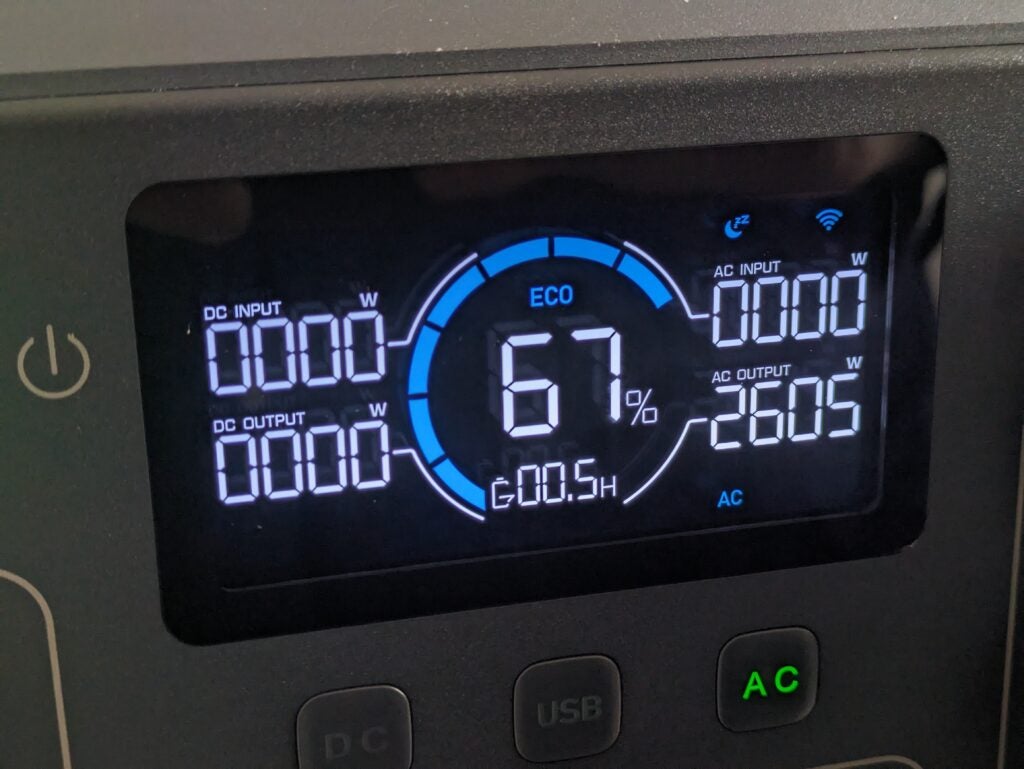
Like other Bluetti power stations I’ve tested, the AC200L never seemed to be working particularly hard. Even during heavy loading, it typically took a while for its cooling fans to start, and longer still for them to step up to high speeds. Even when they did, the AC200L was quite hushed – much more so than the Anker SOLIX F2000 when delivering its maximum output.
To calculate a value-for-money figure for battery power stations, we divide their cost by the amount of power they might store over their working life. Bluetti says the AC200L’s batteries will retain at least 80% of their original capacity after 3000 charge cycles. Assuming they degrade steadily to this point, the AC200L works out at 33p per kWh if you buy it full price, or a very competitive 25p per kWh if you buy it when discounted to £1500.
Latest deals
Should you buy it?
You should buy if you need powerful backup power for the home
This is an excellent, unflappable power station with enough grunt to serve as a decent home backup, or the workhorse for a small camper van.
You should not buy if you want something more portable
The Bluetti AC200L is hard to lug around, and its AC ports, app, and screen could be a little easier to use.
Final Thoughts
The Bluetti AC200L is a great power supply and – if you buy it discounted to £1500 as it was during my review – it’s excellent value. It could handle anything I threw at it, and was very efficient in storing and delivering power. There’s not much to criticise, other than the layout of its AC sockets and the way their rubber bungs can obstruct certain plugs or adaptors.
As a home backup device, I narrowly prefer the Bluetti AC200L to the Anker SOLIX F2000 – it offers a higher maximum output with more flexibility for overloading, is quieter, and can accept a bit more solar power. However, if I was buying for an RV or to supply power to a large camping group, the F2000’s inbuilt light, wheels and handle would probably tip the balance in its favour.
How we test
We test every battery station we review thoroughly over an extended period of time. We use standard tests to compare features properly. We’ll always tell you what we find. We never, ever, accept money to review a product.
Find out more about how we test in our ethics policy.
We test with a variety of devices to see how long the battery will last.
We test different charging methods to see how quickly the battery can be topped up.
FAQs
The main unit has a 2048Wh battery, but you can expand this with up to two additional batteries for a maximum of 8192Wh (about the daily use of a typical home).
Trusted Reviews test data
Verdict
The Bluetti AC200L combines a decent amount of energy storage with a fairly high peak output, making it suitable as a portable backup to almost any device in the home. It’s well-served for ports, and remains quiet and unruffled even when providing its maximum power output. Throw in fast charging, good solar support, and a reasonable app, and the AC200L is a very impressive device overall – particularly if you can pick it up for its discounted price of around £1400.
Pros
- Quite a heavy-duty supply
- Quiet and efficient, even at high loads
- Good value
Cons
- Top mains power sockets are compromised
- Very difficult to move around
-
A medium-heavy duty power stationThe AC200L can store 2,048 watt-hours of electricity, and satisfy peak demands of 2.4 kilowatts (kW). That’s enough to run most household goods including laundry devices, but it’s a bit short for some kettles or heaters. -
A good range of ports, but heavyThis power supply has four USB ports, four mains outputs and a car power port. It can charge from the mains, solar power, or both, potentially filling up in less than 90 minutes. It weighs almost 30kg, though.
Introduction
If you want a highly portable battery power supply, the Bluetti AC200L isn’t it. At 28.3kg and about the size of a microwave, it’s probably more accurate to describe it as ‘movable’.
Don’t let that count against it, though: it’s the unavoidable downside of packing in enough Lithium Iron Phosphate (LFP) batteries to store 2048 watt-hours of electricity – that’s roughly enough to run a kettle for 40 minutes.
This is a fairly heavy-duty supply, then, and Bluetti has made the most of its size by fitting in four USB ports, a car-style power socket, and four mains sockets. These can output a maximum of 2.4 kilowatts (kW) between them, which is enough to run almost anything except the most demanding heaters and kettles – and the AC200L has a trick up its sleeve to cope with those, too.
The AC200L competes with other mid-heavy duty supplies including Anker’s SOLIX F2000, which has fairly similar specifications. So, how does it shape up?
Design and features
- Not very portable
- Plenty of ports
- Useful app control via Wi-Fi or Bluetooth
It’s important to be clear that the Bluetti AC200L really isn’t something you’d want to move about very often. It’s certainly too heavy for a single person to lift for any distance, and even a fit and healthy person would find it an effort to get it up a flight of stairs.
This makes it much less suitable for large camping groups than the SOLIX F2000, which has wheels and a telescopic handle to help you shift it around.

Viewed as a movable supply for the home or a small camper van, however, the AC200L makes lots of sense. It can store enough energy to power a fridge-freezer for a day or two, or cover at least one wash load in a modern machine. It’s certainly up to making a few rounds of toast or several pots of coffee, although you might need to alternate between high-power kitchen or laundry devices to avoid overloading it.
All of the AC200L’s power outputs are on the front panel, and each is covered by a thick rubber bung. These give some protection against a small splash of dust or water, but the AC200L isn’t weatherproofed. Its four USB ports are split between two USB-A sockets, each rated for up to 18W, and two USB-C ports each good for 100W. The cigarette lighter-style car outlet is rated for 120W, while there’s an additional 48 volt, 8 amp RV outlet.
This power supply’s four AC sockets are arranged in a square, but the top two are inverted. This could be helpful if you’re connecting a device placed behind it, but it also means that top-heavy AC adaptors can obstruct a neighbouring socket.

More significantly, I found that the bungs on the top sockets wouldn’t completely fold clear of the cable exit from a standard plug, meaning that I couldn’t get them fully inserted. The bottom sockets don’t have this problem. If I was keeping my sample, I’d consider removing the bungs from its top sockets.

Bluetti has also put screw caps or bungs over the various power input ports, which are clustered together on the AC200L’s left-hand panel. You connect it to the mains via an unusual circular port, to which the supplied cable is secured by a locking ring. DC power sources connect to a similar two-pole port, while there’s also a grounding connector – handy to have if, for some reason, your grid connection doesn’t offer earthing.
Bluetti supplies DC cable adaptors for car and solar charging, though it’s worth noting that the latter uses MC4 connectors, rather than the XT60 plugs you get on most portable solar panels.

The final port is a heavy-duty expansion connector supporting a range of external batteries. You can double the AC200L’s storage to 4096Wh with a single Bluetti B230 battery, or take it to 6348Wh with two B210 units. You can even add two B300 batteries to get a 8192Wh maximum. Note, though, that adding batteries just increases the AC200L’s stamina – it doesn’t expand the maximum 2400W of power it can deliver at any given moment.
This power supply uses a typical Bluetti display, which shows at a glance the battery state and whether it’s charging, discharging or neither. Either way, there’s also an estimated time until the battery is full or empty, together with the detail of incoming and outgoing AC and DC power. My only real complaint is that when these values are zero, the screen displays zeros rather than simply showing nothing – it’s quite busy as a result.

Things are clearer in the app. Here you can also switch the AC, DC and USB circuits on and off, and it’s easier to configure the various charging modes.
The app also makes it simple to configure the AC200L’s Eco feature – which can switch off the various outputs when they’re no longer being used – and to enable the Power Lifting mode.

The Bluetti AC200L can operate as an uninterruptible power supply in four different modes. The default setting keeps the battery charged with whatever power is available until it fails, at which point the AC200L switches to the power stored in the batteries.
In time-control mode, the AC200L can be scheduled to charge using off-peak electricity, then provide battery power during peak times to help lower your bills. There’s a PV-priority mode, in which priority is given to charging from available solar power, but you can configure your own custom behaviour if you prefer.
Charging
- Charge from mains, car, or the sun
- Maximum 2400W total charging power
- Full recharge in less than 90 minutes
As you’d probably expect, the Bluetti AC200L can be charged from mains power, the sun, or a car. Given that the latter tops out at 120W, you’d need to be on a transcontinental jaunt to fully recharge its 2048Wh batteries – it would take more than 17 hours. Better to stick to mains charging, which is supported at up to 2400W, or use solar panels with a maximum of 1200W. You can combine both for a maximum of 2400W, comprising 1200W from each.
The AC200L defaults to 1200W mains charging. In this mode, I timed a full recharge at two hours and six minutes, with a total power consumption of 2.35 kilowatt hours (kWh). Assuming this took the 2.05kWh batteries from fully empty to fully charged, that’s an efficiency of 87.3%. It was fractionally more efficient in the ‘Silent’ charging mode, which took just under three hours, consuming 2.34kWh for an efficiency of 87.6%.
I wanted to test the fastest ‘Turbo’ charging mode, but this was initially a bit disappointing, with the AC200L dropping from 2400W charging down to 1200W after adding only 15% or so to the battery. I needed to try again after the AC200L had cooled, after which it remained at 2400W until it was nearly fully charged. A full recharge took 75 minutes – 15 minutes quicker than Bluetti’s claims. In this time, the AC200L used 2.4kWh, for a charging efficiency of 85.3%.
It’s worth pointing out that the Silent charging mode is a misnomer, as the fan will operate occasionally when it’s needed. Still, even when charging flat out, the AC200L remained quite quiet, and was easy to background among the noise of my home office.
One niche concern is that you can’t limit the AC200L’s charging below about 800W. That might make it unsuitable for situations where you only have a very limited mains connection available, such as a low-power campsite hookup or a low-power generator.
Performance
- Stable power output with very quiet fans
- Good round-trip efficiency
- Mighty Power Lifting mode
As with most other battery power supplies I’ve tested, the Bluetti AC200L had no problem providing its rated 2400W for as long as the battery lasted. To probe its performance at full power, I used it to charge two other battery power stations demanding 2200W and 200W, for a 2400W total. The AC200L displayed a sustained output of around 2.49kW, and fully discharged its battery over 49 minutes, providing 1.77kWh in the process.
After recharging, I tested the AC200L two more times with a 1050W mid-range load, and a 200W low power load. It provided 1.9kWh and 1.76kWh respectively in these tests, giving an overall efficiency of between 86.0% and 92.6%. That’s impressive. I calculated a more round-trip (charging and discharging) efficiency of 81.1% – only a point or so down on the best I’ve seen.
I usually connect power stations to a USB load and measure their capacity when providing DC power, but here I encountered a problem. My standard load is another power bank, capable of either providing or accepting power over USB-C. For some reason, the two devices couldn’t agree which was providing the power, and the smaller bank wouldn’t charge. While I’ve not had this issue before, it’s a bit of a niche problem, unlikely to be an issue for the average user.
I also wanted to test this power supply’s Power Lifting mode, which is broadly equivalent to the SurgePad feature appearing on the latest alternatives from Anker. Both are designed to run certain devices that have a power rating above the power station’s normal capacity. They do this by limiting the output voltage and current to prevent the connected device from drawing its full rated power. This works perfectly with simple ‘resistive’ devices like a kettle, but it’s not suitable for voltage-sensitive appliances such as dishwashers, microwaves or the like.
The AC200L’s strong output power makes it harder than usual to test this. Only certain electric heaters and kettles are suitable, and I didn’t have any rated between the supported 2400 and 3000 Watts. Instead, I combined my 1800W-rated kettle and 1250W toaster for a theoretical 3050W total. With Power Lifting enabled, the AC200L limited this to about 2000W, and both devices worked normally together.
It’s worth mentioning that this power supply can actually handle an overload of up to 3kW for two minutes, and it was happy to run the above setup for a time even without Power Lifting enabled. The feature is perhaps more useful on the European version, on which it can support suitable devices rated up to the 3600W (16A) maximum supported by a European socket.
I overloaded the AC200L again when running both my washing machine and heat pump dryer from it. It took a 2600W load in its stride for a couple of minutes before shutting its AC sockets off.

Like other Bluetti power stations I’ve tested, the AC200L never seemed to be working particularly hard. Even during heavy loading, it typically took a while for its cooling fans to start, and longer still for them to step up to high speeds. Even when they did, the AC200L was quite hushed – much more so than the Anker SOLIX F2000 when delivering its maximum output.
To calculate a value-for-money figure for battery power stations, we divide their cost by the amount of power they might store over their working life. Bluetti says the AC200L’s batteries will retain at least 80% of their original capacity after 3000 charge cycles. Assuming they degrade steadily to this point, the AC200L works out at 33p per kWh if you buy it full price, or a very competitive 25p per kWh if you buy it when discounted to £1500.
Latest deals
Should you buy it?
You should buy if you need powerful backup power for the home
This is an excellent, unflappable power station with enough grunt to serve as a decent home backup, or the workhorse for a small camper van.
You should not buy if you want something more portable
The Bluetti AC200L is hard to lug around, and its AC ports, app, and screen could be a little easier to use.
Final Thoughts
The Bluetti AC200L is a great power supply and – if you buy it discounted to £1500 as it was during my review – it’s excellent value. It could handle anything I threw at it, and was very efficient in storing and delivering power. There’s not much to criticise, other than the layout of its AC sockets and the way their rubber bungs can obstruct certain plugs or adaptors.
As a home backup device, I narrowly prefer the Bluetti AC200L to the Anker SOLIX F2000 – it offers a higher maximum output with more flexibility for overloading, is quieter, and can accept a bit more solar power. However, if I was buying for an RV or to supply power to a large camping group, the F2000’s inbuilt light, wheels and handle would probably tip the balance in its favour.
How we test
We test every battery station we review thoroughly over an extended period of time. We use standard tests to compare features properly. We’ll always tell you what we find. We never, ever, accept money to review a product.
Find out more about how we test in our ethics policy.
We test with a variety of devices to see how long the battery will last.
We test different charging methods to see how quickly the battery can be topped up.
FAQs
The main unit has a 2048Wh battery, but you can expand this with up to two additional batteries for a maximum of 8192Wh (about the daily use of a typical home).
























